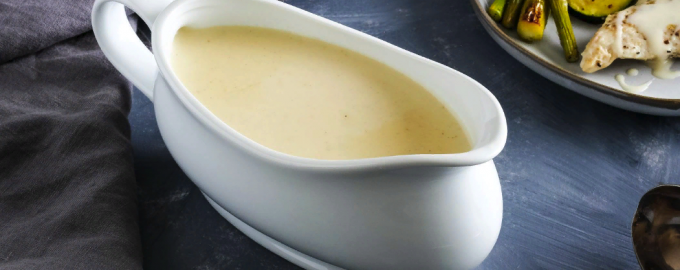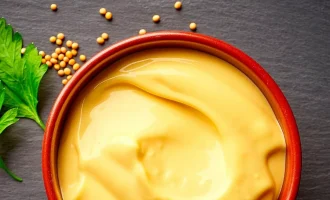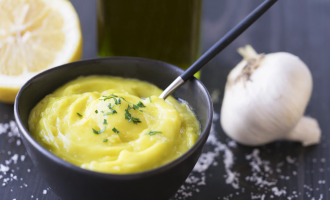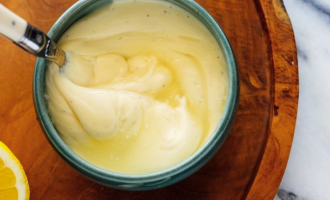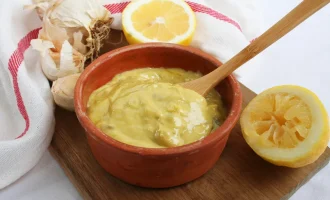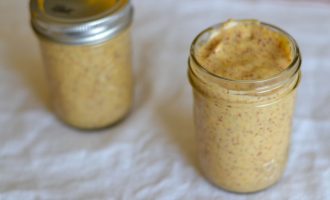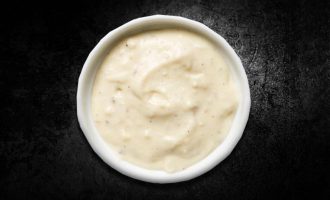Ingredients
- 50g butter
- 50g all-purpose flour
- 500ml milk
- Salt to taste
- White pepper to taste
- Nutmeg (optional)
Per serving
Calories: 350 kcal
Proteins: 5 g
Fats: 35 g
Carbohydrates: 8 g
Method
-
In a saucepan, melt the butter over medium heat until it starts to bubble.
-
Add the flour to the melted butter and whisk continuously to form a smooth paste, known as a roux.
-
Cook the roux for a couple of minutes, stirring constantly to prevent it from burning. This will help cook out the raw flour taste.
-
Gradually pour in the milk while whisking vigorously to avoid any lumps from forming.
-
Continue to cook the sauce over medium heat, stirring constantly, until it thickens to the desired consistency. This should take around 10-15 minutes. If the sauce becomes too thick, you can add more milk to thin it out.
-
Season the sauce with salt, white pepper, and a pinch of nutmeg (if desired) to enhance the flavors. Adjust the seasoning according to your taste preferences.
-
Once the sauce has reached the desired consistency and flavor, remove it from the heat.
The Allemande sauce is typically served with grilled or roasted meats, poultry, or vegetables. It pairs well with dishes such as chicken breasts, pork tenderloin, or steamed asparagus.
In conclusion, Allemande sauce is a classic French white sauce made with a roux base of butter and flour, combined with milk to create a creamy and rich texture. It is a versatile sauce that complements a wide range of dishes and adds a delicious flavor to the ingredients it is served with.
Facts about Allemande sauce:
- Historical Origin: Allemande sauce is believed to have originated in France during the 17th and 18th centuries. It was a popular sauce during the time of Louis XIV, the Sun King.
- Derivation of the Name: The sauce’s name, “Allemande,” means “German” in French. However, despite the name, the sauce is not of German origin. It is thought to be named in honor of the German cooks who worked in French kitchens during that era.
- Classic Sauce of French Cuisine: Allemande sauce is one of the five classic “mother sauces” of French cuisine, as classified by renowned chef Auguste Escoffier. These mother sauces form the basis for numerous derivative sauces in French cooking.
- Roux-based Sauce: Allemande sauce is a roux-based sauce, which means it is made by combining a cooked mixture of butter and flour. This creates a thickening agent that gives the sauce its smooth and creamy texture.
- Flavor Profile: The sauce has a rich, velvety texture and a mild, creamy taste. It is often described as having a delicate balance of flavors, with a subtle hint of nutmeg adding depth to the sauce.
- Variations and Adaptations: While the traditional Allemande sauce recipe consists of butter, flour, and milk, variations may include the addition of egg yolks, white wine, or lemon juice to enhance the flavor and create different variations of the sauce.
- Versatile and Complementary: Allemande sauce is known for its versatility and ability to complement a variety of dishes. It is commonly served with roasted or grilled meats, poultry, fish, vegetables, and even eggs.
- Modern Usage: Although Allemande sauce has historical significance, it is still utilized in modern culinary preparations. Chefs and home cooks often use it as a base sauce or as a component in other complex sauce preparations.
- Sauce Pairings: Apart from being served with meat and vegetables, Allemande sauce is also a popular choice for accompanying dishes like veal, roasted turkey, eggs Benedict, and various seafood preparations.
- Culinary Applications: Allemande sauce can be utilized as a standalone sauce, poured over the main dish, or used as a component in other recipes. It provides a smooth and creamy texture that adds depth and flavor to various culinary creations.

